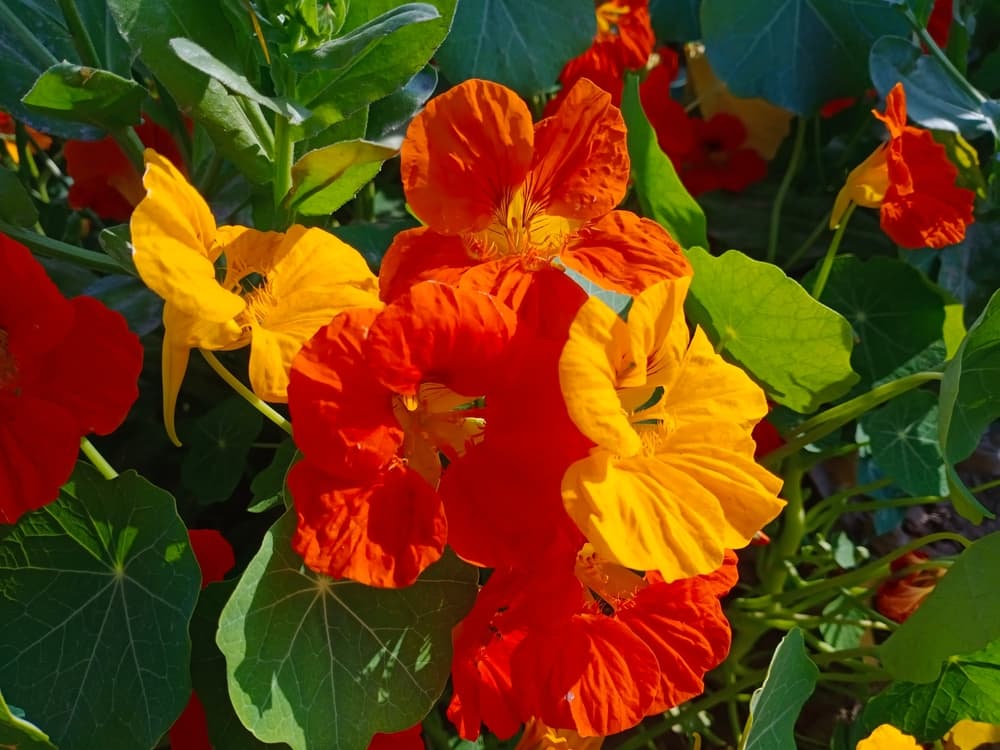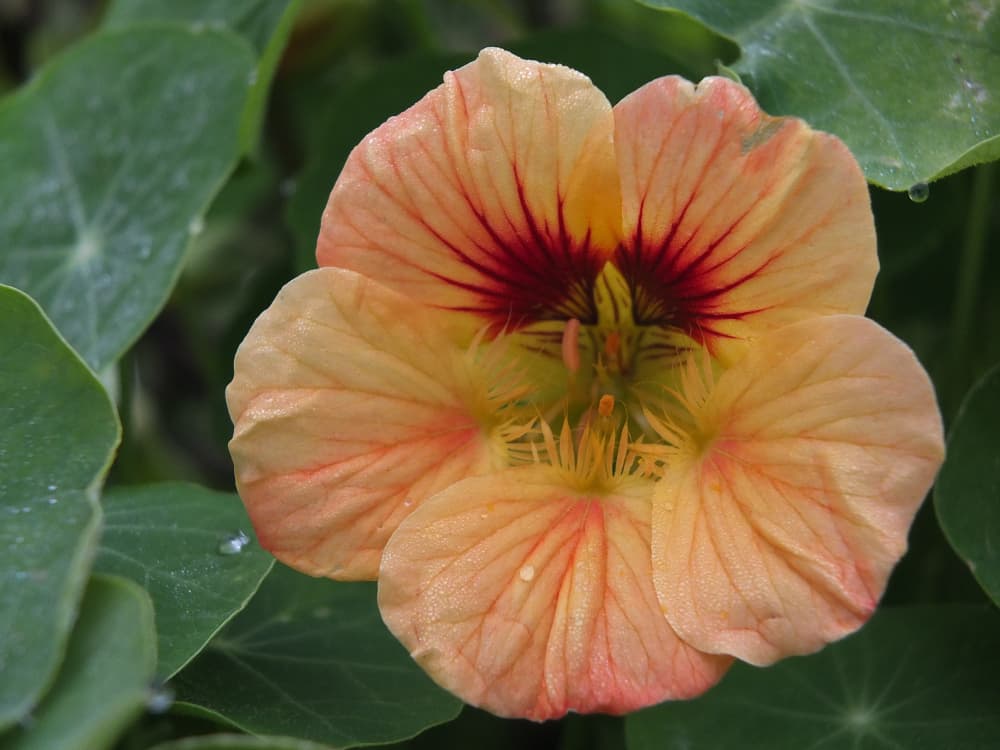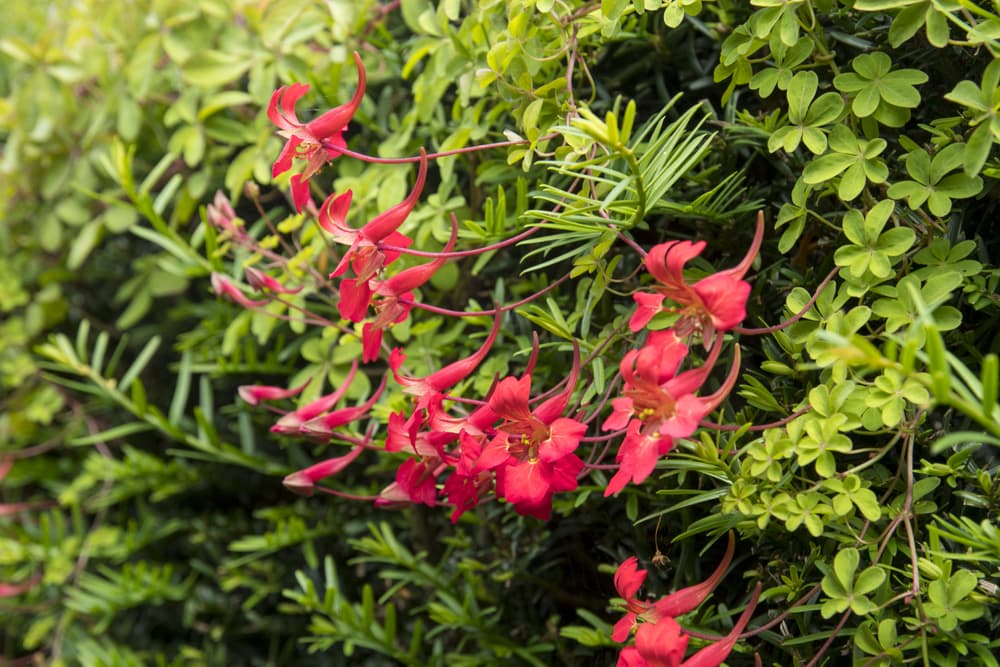10 Enchanting Tropaeolum (Nasturtium) Varieties Including Some Lesser Seen Species

ANNUALS > NASTURTIUM > VARIETIES
Reviewed By COLIN SKELLY

Colin is a Horticulturist and Horticultural Consultant with experience in a range of practical and managerial roles across heritage, commercial and public horticulture. He holds the Royal Horticultural Society’s Master of Horticulture award and has a particular interest in horticultural ecology and naturalistic planting for habitat and climate resilience.
IN THIS GUIDE
NASTURTIUM GUIDES
Companion Planting
Container Growing
Indoors Growing
Sowing
Varieties
Nasturtiums hail from South and Central America and have been introduced to a motley assortment of countries spanning all continents and covering temperate, sub-tropical, and tropical zones.1Crawford, B. (n.d.). Nasturtiums: Great for the Garden and Table. New Jersey Agricultural Experiment Station. Retrieved March 21, 2023, from https://njaes.rutgers.edu/plant-of-the-month/tropaeolum-majus.php
The plant’s given name, Tropaeolum, is usually restricted to formal use with the plant being known in the English-speaking world and even elsewhere by its common name ‘Nasturtium’.
Genus Tropaeolum comprises just under 100 species (all native to Central and South America).2Tropaeolum. (n.d.). Kew Royal Botanic Gardens. Retrieved March 21, 2023, from https://powo.science.kew.org/taxon/urn:lsid:ipni.org:names:30002592-2
From among the many species and cultivars of Tropaeolum we present a top ten list of our favourite varieties, which also turns out to be a fairly diverse and representative selection:
1) Dwarf Nasturtium

Botanical Name: T. minus
The species that ‘started it all’ in Europe.
It is native to Ecuador and Peru, growing at altitude.
A trailing, dwarf species, it grows to 30cm with a spread only marginally bigger.
It blooms from mid-summer to early autumn and the small, funnel-shaped flowers are a buttercup yellow with darker amber-to-red splotches.
2) Garden Nasturtium

Botanical Name: T. majus
is native to a swath of land from Colombia to Bolivia.
It has a height and spread of 2-2.5m – it too blooms from mid-summer to early autumn.
It has open, disk-shaped flowers in deep, rich tones of yellow, orange, and red with sizes ranging from 3-6cm.
It is the parent species of some of the most widely-available and popular varieties.
3) ‘Ladybird’

Botanical Name: T. minus ‘Ladybird‘
A cultivar of T. minus that is even shorter at only 20cm.
The leaves are very much shield-shaped and the flowers are a cheery yellow with brilliant red ‘ladybird’ spots at the proximal end of each petal.
It blooms from early summer into autumn.
4) ‘Black Velvet’

Botanical Name: T. minus ‘Black Velvet’
May not bear actual black flowers but they do have a very dark flush and the deep creases in the petals also create shadows on the flowers whose colour varies from blood red to mahogany.
They have a bright yellow centre.
This bushy variety is about 30cm high with a similar spread – it blooms from mid-summer into autumn.
5) ‘Chameleon’

Botanical Name: T. majus ‘Chameleon’
A cultivar of T. majus, is also a bushy variety with a height and spread of about 30cm.
Its leaves are nearly round and it produces particularly eye-catching flowers.
Salver-shaped, they are of a pale yellow colour with large red-to-crimson ‘splatters’ on each petal.
As the flower matures it undergoes a chameleon-like colour-shift from yellow to light pink!
It blooms from mid-summer into autumn.
6) ‘Empress Of India’

Botanical Name: T. majus ‘Empress of India’
An old heirloom variety.
It has a bushy habit with a height and spread of 35-40cm and features wonderfully rounded sea-green leaves.
The funnel-shaped flowers range in hue from vermilion through scarlet to crimson, and sometimes develop a purple flush.
It blooms from mid-summer into autumn. A superb choice for patios and planters.
7) Flame Nasturtium

Botanical Name: T. speciosum
Comes from the highlands of Chile and it is well known to grow strongly in the highlands of Scotland, as one of the hardiest varieties, rated to Zone H5.
It is of a climbing type and reaches heights from 3-4m.
The star-shaped flowers are about 2cm across and, as its name suggests, are of a fiery orange colour.
These have especially prominent spurs and this plant is a recipient of the RHS Award of Garden Merit.
8) Blue Nasturtium
Botanical Name: T. azureum
Blue Nasturtium is also from Chile but this one is not frost-hardy.
It is of the less-common summer-dormant type that retains its foliage from autumn through winter into spring, which would lend fantastic colour to the garden because its leaves are of a light, bright green and are palmately lobed.
It grows to only about 1m.
A short flowering season in spring yields delightful flowers.
They are disk- or salver-shaped, and are of a gentle lilac-to-purple hue with a cream centre.
9) Canary Creeper

Botanical Name: T. peregrinum
Hails from Peru and is a very popular variety in the United States.
‘Canary Creeper’ at one and the same time is a misnomer and is also very apt.
This plant is very much of the climbing type; what’s more, it grows to about 3m and can even reach 4m.
However, the flowers are a perfect canary yellow and they even bring to mind canary wings, thanks to the narrow, fringed, ‘fluttering’ petals!
The deeply lobed leaves are of a rich green hue.
10) Three-Coloured Nasturtium

Botanical Name: T. tricolor
Surely boasts one of the most uncommon and gorgeous flowers.
It is also uncommon as a summer-dormant species.
T. tricolor is native to Chile and is a climber, reaching heights of 1-1.5m.
The pinnately lobed leaves are of a rich green shade – and as for the small but outrageous blooms, they actually comprise of a pronounced calyx enclosing the flower.
The flower is yellow, often with greenish edging, and the calyx is orange-red with purple-to-crimson edging.
This species even boasts a long blooming season that lasts from mid-winter to early summer.
“Tropaeolum tricolor is my favourite nasturtium, combining an exotic flower first blooming at a time of year you wouldn’t expect to see it,” shares Master Horticulturist Colin Skelly.
“It needs full sun and a mild location to thrive outdoors or grow in a container on a trellis and move indoors in winter.”
Winner of the RHS Award of Garden Merit.
Other recommended varieties include:
- T. majus ‘Hermine Grashoff’
- T. majus ‘Alaska’
- T. majus ‘Whirlybird’
- T. majus ‘Milkmaid’
- T. majus ‘Jewel Cherry Rose’
- T. tuberosum
- T. polyphyllum
- T. leptophyllum
- T. hookerianum
- T. austropurpureum.
References
- 1Crawford, B. (n.d.). Nasturtiums: Great for the Garden and Table. New Jersey Agricultural Experiment Station. Retrieved March 21, 2023, from https://njaes.rutgers.edu/plant-of-the-month/tropaeolum-majus.php
- 2Tropaeolum. (n.d.). Kew Royal Botanic Gardens. Retrieved March 21, 2023, from https://powo.science.kew.org/taxon/urn:lsid:ipni.org:names:30002592-2

